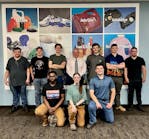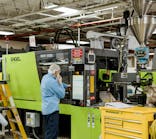The Following are examples of collaborative robots available for the plastics processing industry:
UR3, UR5, UR10/Universal Robots
Universal Robots (UR), part of North Reading, Mass.-based Teradyne, introduced its first collaborative robot in 2008, claiming to launch the cobot industry. The product portfolio includes the collaborative UR3, UR5 and UR10 robotic arms named after their payloads in kilograms. The UR robots measure electrical current in the joints to determine force and movement. If the robot arm measures a force stronger than what it is programmed for, it automatically stops.
1 YuMi/ABB Robotics
ABB introduced the world's first microprocessor-controlled, all-electric industrial robot in 1974, and this year introduced its first collaborative robot, the YuMi or "you and me." Padded, magnesium arms flex on seven axes and can stop in milliseconds if necessary, according to ABB. The cobot was designed in China, specifically targeting electronics assembly, but ABB will be pitching it to the plastics industry at K 2016. The YuMi is table mounted and has a small payload, 1.1 pounds. Reach is 19.7 inches.
2 LBR iiwa/Kuka
The Kuka entry is at the high end of the collaborative robot market, with a price of $68,000 and payloads up to 30.9 pounds. The reach of the higher-end model is 32.2 inches. One of the companies testing the LBR iiwa is Volkswagen, which is looking for ways to cut labor costs. At the Hannover trade fair in Germany, Kuka demonstrated the ability of its robots to communicate data to the internet. Kuka will also exhibit at the K show.
Baxter & Sawyer/Rethink Robotics
Baxter became one of the early collaborative robots deployed in the North American plastics processing industry when global custom injection molder Nypro installed one in early 2013 in its Clinton, Mass., facility. Manufactured in New Hampshire, Baxter was the brainchild of robotics pioneer Rodney Brooks, one of the founders of iRobot. Baxters shipped today are three times faster and twice as precise as those shipped in 2013, according to Jim Lawton, chief product and marketing officer at Rethink Robotics. Sawyer now comes in a newer version with a payload of 8.8 pounds.
CR-35iA/Fanuc
Introduced last year, Fanuc's collaborative robot offers a payload of 77.2 pounds, the best in the industry. Its reach is almost 6 feet. Applications include assembly and heavy-duty parts transfer. The CR-35iA has a pedestal that is fixed to the floor. The R-30iB controller uses Fanuc's iPendant, which displays process information and the actual process path. Fanuc is a $6 billion-plus company and describes itself as the leading supplier of robot automation in North America. Fanuc is also a K 2016 exhibitor.
3 HC10/Yaskawa Motoman
Yaskawa's FSU safety controller debuted in 2008, introducing the concept of safety-minded robots. Sensor-based barriers (light curtains) are still needed to detect ingress into the robot workspace. Yaskawa is introducing a Power and Force Limiting collaborative robot, called HC10, early next year. It also limits the amount of power and force it can transmit during a collision. Dual torque sensors are used in each joint of the robot. Joint torque sensing provides the required sensitivity while still retaining the arm stiffness that is needed for smooth and high-speed motion, according to the company.






